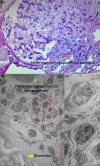Hypokalemia, hypomagnesemia, hypocalciuria, and recurrent tetany: Gitelman syndrome in a Chinese pedigree and literature review
- PMID: 28469853
- PMCID: PMC5412754
- DOI: 10.1002/ccr3.874
Hypokalemia, hypomagnesemia, hypocalciuria, and recurrent tetany: Gitelman syndrome in a Chinese pedigree and literature review
Abstract
Gitelman syndrome is an autosomal recessive disease mostly associated with loss-of-function mutations of the SLC12A3 gene and featured by clinical hypokalemia, hypomagnesemia, hypocalciuria, and histologically hypertrophy of the juxtaglomerular apparatus. A novel homozygous mutation (p.Arg399Pro) at the extracellular domain of SLC12A3 was found and correlated with the severe clinical manifestations.
Keywords: Gitelman syndrome; SLC12A3; phenotype–genotype relation; review.
Figures



Similar articles
-
A novel SLC12A3 gene homozygous mutation of Gitelman syndrome in an Asian pedigree and literature review.J Endocrinol Invest. 2016 Mar;39(3):333-40. doi: 10.1007/s40618-015-0371-y. Epub 2015 Aug 11. J Endocrinol Invest. 2016. PMID: 26260218 Review.
-
Mutations in SLC12A3 and CLCNKB and Their Correlation with Clinical Phenotype in Patients with Gitelman and Gitelman-like Syndrome.J Korean Med Sci. 2016 Jan;31(1):47-54. doi: 10.3346/jkms.2016.31.1.47. Epub 2015 Dec 24. J Korean Med Sci. 2016. PMID: 26770037 Free PMC article.
-
A novel compound heterozygous variant of the SLC12A3 gene in Gitelman syndrome pedigree.BMC Med Genet. 2018 Jan 29;19(1):17. doi: 10.1186/s12881-018-0527-7. BMC Med Genet. 2018. PMID: 29378538 Free PMC article.
-
Novel compound heterozygous variants of SLC12A3 gene in a Chinese patient with Gitelman syndrome: a case report.Front Genet. 2023 Jun 12;14:1067242. doi: 10.3389/fgene.2023.1067242. eCollection 2023. Front Genet. 2023. PMID: 37377595 Free PMC article.
-
A novel SLC12A3 homozygous c2039delG mutation in Gitelman syndrome with hypocalcemia.BMC Nephrol. 2018 Dec 17;19(1):362. doi: 10.1186/s12882-018-1163-3. BMC Nephrol. 2018. PMID: 30558554 Free PMC article. Review.
Cited by
-
Genetic Analysis of SLC12A3 Gene in Chinese Patients with Gitelman Syndrome.Med Sci Monit. 2019 Aug 9;25:5942-5952. doi: 10.12659/MSM.916069. Med Sci Monit. 2019. PMID: 31398183 Free PMC article.
-
Clinical Characteristics and Gene Mutation Analysis of the Chinese Han Population with Gitelman Syndrome: 3 Case Reports and a Literature Review.Case Rep Med. 2020 Oct 24;2020:6263721. doi: 10.1155/2020/6263721. eCollection 2020. Case Rep Med. 2020. PMID: 33163079 Free PMC article.
-
Novel heterozygous missense mutation of SLC12A3 gene in Gitelman syndrome: A case report.World J Clin Cases. 2019 Jun 26;7(12):1522-1528. doi: 10.12998/wjcc.v7.i12.1522. World J Clin Cases. 2019. PMID: 31363482 Free PMC article.
-
Gitelman syndrome and primary hyperparathyroidism: a rare association.BMJ Case Rep. 2018 Jun 5;2018:bcr2017223663. doi: 10.1136/bcr-2017-223663. BMJ Case Rep. 2018. PMID: 29871958 Free PMC article.
-
Diagnosis and outpatient management of Gitelman syndrome from the first trimester of pregnancy.BMJ Case Rep. 2021 May 12;14(5):e241756. doi: 10.1136/bcr-2021-241756. BMJ Case Rep. 2021. PMID: 33980557 Free PMC article.
References
-
- Gitelman, H. , Graham J., and Welt L.. 1966. A new familial disorder characterized by hypokalemia and hypomagnesemia. Trans. Assoc. Am. Physicians 79:92–96. - PubMed
-
- Simon, D. B. , Nelson‐Williams C., Bia M. J., Ellison D., Karet F. E., Molina A. M., et al. 1996. Gitelman's variant of Bartter's syndrome, inherited hypokalaemic alkalosis, is caused by mutations in the thiazide‐sensitive Na‐Cl cotransporter. Nat. Genet. 12:24–30. - PubMed
-
- Gennari, F. J. 1998. Hypokalemia. N Engl J Med. 339:451‐8. - PubMed
-
- Pollak, M. R. , Delaney V. B., Graham R. M., and Hebert S. C.. 1996. Gitelman's syndrome (Bartter's variant) maps to the thiazide‐sensitive cotransporter gene locus on chromosome 16q13 in a large kindred. J. Am. Soc. Nephrol. 7:2244–2248. - PubMed
Publication types
LinkOut - more resources
Full Text Sources
Other Literature Sources

